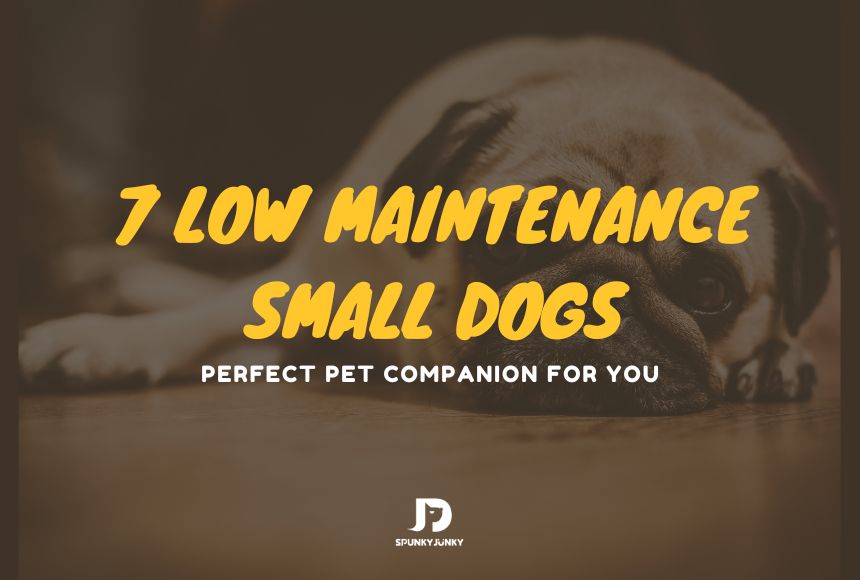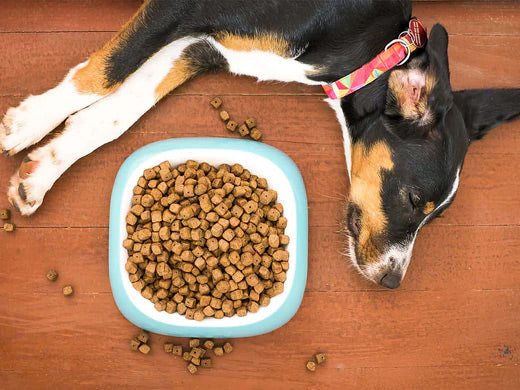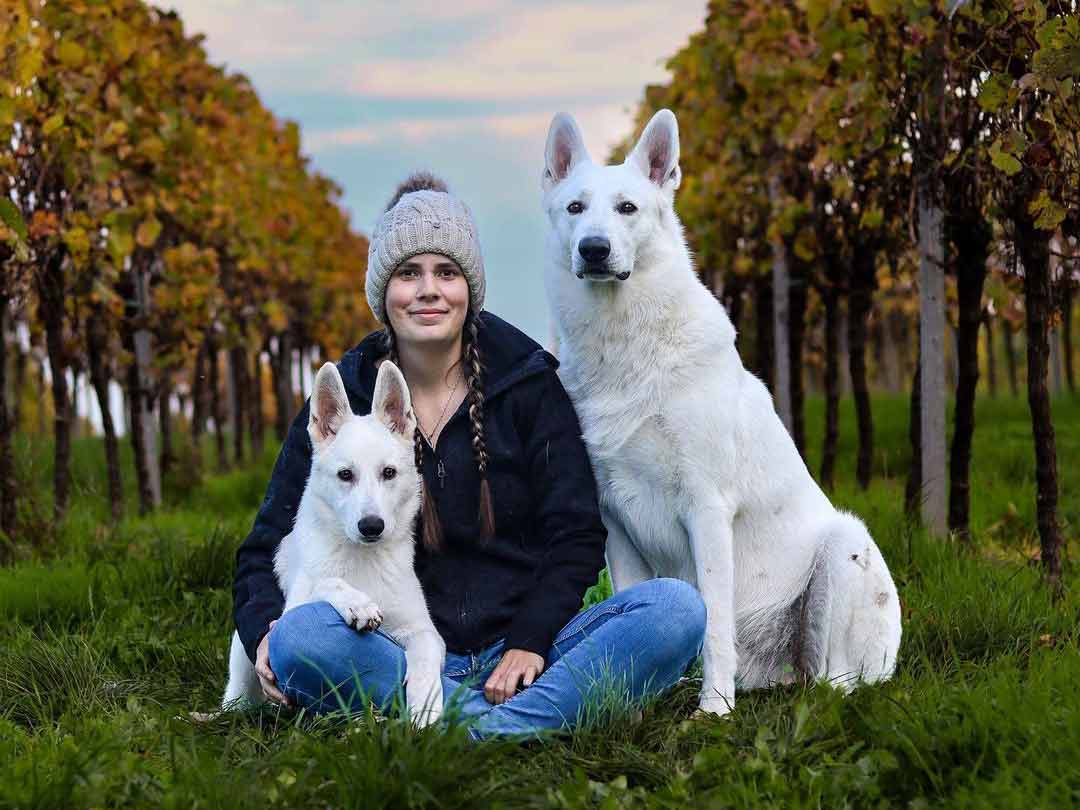As many districts in the United States and the United Kingdom went into lockdown in March 2020, millions of people were forced to stay at home.
Meanwhile, social media platforms like Instagram and Tiktok were flooded with cute pet dog photos and videos. It seems that those fluffy animals became the biggest psychological relief for people during the epidemic period.
However, not all pet dogs are easy to deal with. Some may even become the owner’s nightmare. Therefore, you must learn about low-maintenance pet dog breeds before you make the wrong decision.
So here to help you out, we list seven small dog breeds that make the perfect low maintenance pets for your reference.
What Means Low Maintenance Dogs?
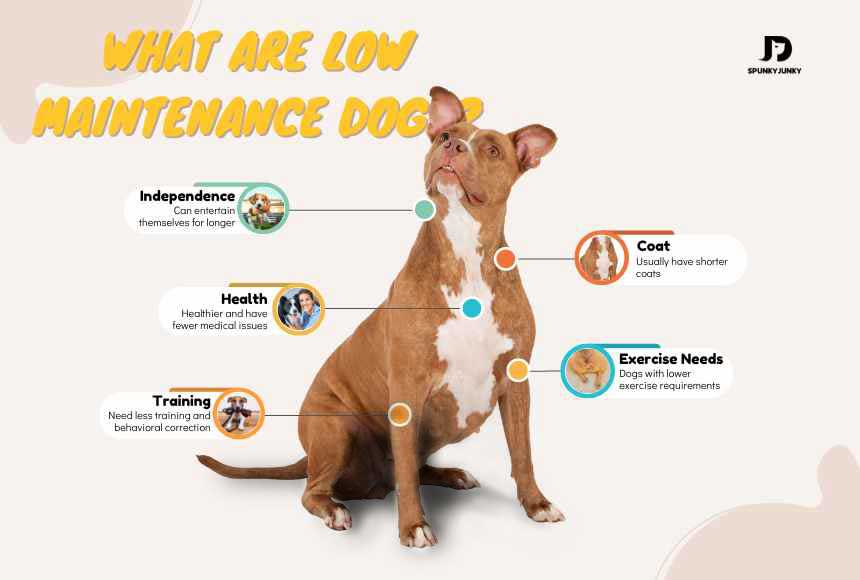
"Low maintenance dogs" refers to dog breeds or individual dogs that require relatively little time, effort, or resources to care for compared to other breeds. These dogs typically have specific traits or characteristics that make them easier to manage in terms of grooming, exercise, training, and overall care. Here are some factors that contribute to a dog being considered low maintenance:
- Coat: Low maintenance dogs usually have shorter coats that require less grooming. They shed less frequently or have hair that is easier to manage and doesn't tangle easily.
- Exercise needs: Dogs with lower exercise requirements are often considered low maintenance. These breeds are content with shorter walks or indoor play sessions rather than demanding extensive exercise routines.
- Training: Some dogs are naturally more obedient and eager to please, requiring less training and behavioral correction. These breeds may be quick learners and less prone to destructive behavior.
- Health: Low maintenance dogs are generally healthier and have fewer medical issues. They require fewer visits to the vet and may have a lower risk of developing hereditary conditions.
- Independence: Certain dog breeds are more independent and can entertain themselves for longer periods without becoming anxious or destructive. They don't require constant attention or human interaction.
However, it's important to note that even low maintenance dogs require proper care, attention, and socialization. While they may be less demanding in some areas, all dogs still require adequate exercise, mental stimulation, regular vet check-ups, and a loving environment.
So, What Dogs Are Low Maintenance Small Dogs?
Now you guys know what means low maintenance dogs, let me introduce 7 low maintenance small dogs for you:
1. Pug

Origin: China
Size: Small
Breed Group: Toy Group
Lifespan: 12-15 years
Coat: Short and smooth
Adaptability : ★★★
All-around friendliness : ★★★★
Health And Grooming Needs : ★★★
Trainability : ★★
Exercise needs : ★★★★
Characteristics of Pug: Stubborn, Clever, Mischievous, Docile, Sociable, Attentive, Loving, Calm, Quiet
If you are looking for a dog to keep you happy, a pug is a perfect choice. No matter how mad you are, you can’t stop laughing once you turn to look at the pug’s innocent face. Staying at home is boring. People are driven crazy by long-time social isolation. But having a pug will calm you down and think of the good things. The best thing about pug is that it is very, very, very well-behaved. It barely bites stuff around as long as you play with it. However, it eats a lot and never knows what it is to be full. It would crawl over with all its might to a banana even if it overeats to stand up.
2. Shih Tzu

Origin: Tibet, China.
Size: Small; typically weighing 9 to 16 pounds.
Breed Group: Toy Group.
Lifespan: 10 to 16 years.
Coat: Long, flowing double coat that requires regular grooming to prevent matting.
Adaptability : ★★★
All-around friendliness : ★★★★★
Health And Grooming Needs : ★★
Trainability : ★★★
Exercise needs : ★★★
Characteristics of Shih Tzu: Playful, Intelligent, Affectionate, Clever, Friendly
Shih Tzu is the dog that quietly stays there and enjoys itself, whether you like it or not. I've always loved Shih Tzu from childhood to adulthood because of my Shih Tzu complex. Currently, my family has a purebred Shih Tzu: good personality, hair is not allergic, no hair loss if you regularly give it some hair grooming, doesn’t need too much exercise, happy to accompany the elderly, suitable for owners living in apartments. Shih Tzu is very beautiful, but its intelligence is not high. Therefore training a Shih Tzu is a difficult job. If you want to train your Shih Tzu well, then you must learn the right training methods beforehand. Also, you must be very patient and give your Shih Tzu some snacks to train it again and again.
3. Chihuahua
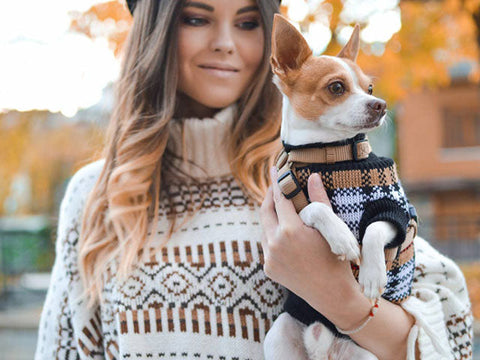
Origin: Mexico
Size: 5-8 inches tall at the shoulder
Lifespan: 12-20 years
Temperament: Feisty, independent, loyal, playful
Health concerns: Eye problems, luxating patellas, hydrocephalus
Adaptability : ★★★
All-around friendliness : ★★★★★
Health And Grooming Needs : ★★
Trainability : ★★★
Exercise needs : ★★★
Characteristics of Chihuahua: Aggressive, Devoted, Lively, Alert, Quick, Courageous
Chihuahua is named after its origin (Chihuahua, Mexico) and is as adorable as the name sounds. Chihuahua is easy to maintain, especially when showering it due to its lightweight. Also, because of its small size, Chihuahua doesn’t eat a lot, saving lots of money for the owner. As for the body odor, as long as you get your Chihuahua spayed or neutered, it won't be a concern. But it would be a small challenge for you to brush its teeth since there isn’t a suitable toothbrush. You’d better use your fingers wrapped in gauze to replace a Chihuahua toothbrush. This cutie pie pet dog won’t frequently ask you to walk and exercise outside. However, when you take it out for a walk, you must get it on a leash in case it runs far away.
4. Wiener Dog
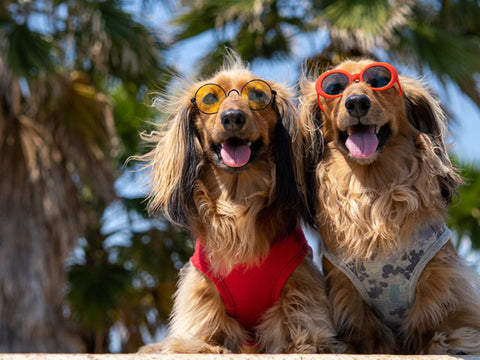
Origin: Germany
Size: Standard (16-32 pounds or 7-15 kg), Miniature (11 pounds or 5 kg and under)
Lifespan: About 12-16 years
Coat: smooth (short-haired), long-haired, and wirehaired.
Adaptability : ★★★
All-around friendliness : ★★★
Health And Grooming Needs : ★★★
Trainability : ★★★★
Exercise needs : ★★★
Characteristics of Wiener dog: Playful, Clever, Stubborn, Devoted, Lively, Independent, Courageous
The wiener dog is featured with a conehead, a tapered snout, long body, short and curved legs, and drooping ears. Wiener dogs originated from in Germany and were trained to hunt badgers. This dog breed has become popular in the USA since the early 1900s. Wiener dogs are famous for being intelligent, active, and brave. They are generally recognized as a good companion for human beings. They are ideal pets for kids. Wiener dogs with longer hair usually require more grooming than their shorter-haired peers. Wiener dog is so clever and intelligent that it can tell whether the visitor is a friend or not according to the owner’s reactions. If you dream of getting easy pets to care for, do not hesitate to get one Wiener dog.
5. English Bulldog
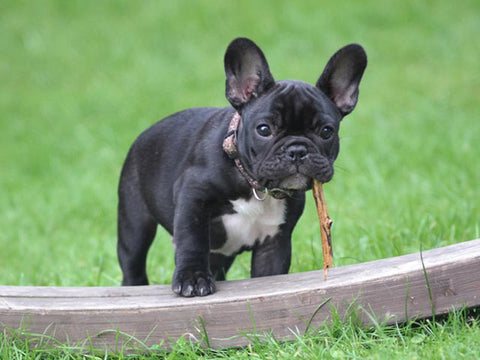
Origin: England
Size: Males weigh around 50-55 pounds
Lifespan: 8-10 years
Coat: Brindle, white, fawn, and pied. They might have a dark mask on their face.
Adaptability : ★★★
All-around friendliness : ★★★
Health And Grooming Needs : ★★
Trainability : ★★★
Exercise needs : ★★★
Characteristics of English Bulldog: Willful, Docile, Friendly, Gregarious
English bulldog, also known as tiger dog, has wrinkles all over its face. Fat, but muscular. Its expressionless face looks a bit fierce. But English bulldog keepers know for real that it is stubborn and nice to get along with. Although its name sounds a little bit threatening, it has a gentle personality. It always knows how to behave appropriately and be friendly. Or maybe it’s too lazy to move, which makes it a gentleman among dog breeds.
The English bulldog is special. Teddy-like puppies will treat themselves as the family's baby, pleasing you every day, while larger dogs will treat themselves as the family's guardian. Only the English bulldog treats itself as a human being, your home as its own home. No matter how much it seems to love you, you are equal to it in its eyes. That’s why English bulldog keepers love the animal so much. Haha!
6. English Springer Spaniel
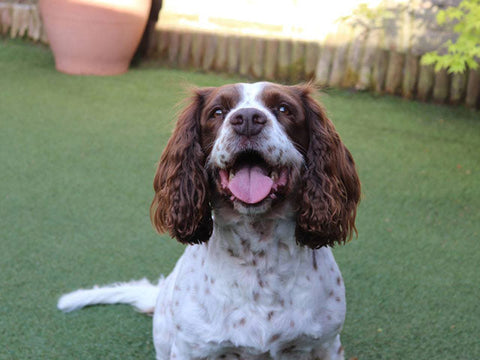
Origin: England
Size: 18-20 inches
Breed group: Sporting
Lifespan: 10-12 years
Coat: Long, wavy, or curly; can be any color
Adaptability : ★★★
All-around friendliness : ★★★★★
Health And Grooming Needs : ★★★
Trainability : ★★★★
Exercise needs : ★★★★★
Characteristics of English Springer Spaniel: Intelligent, Affectionate, Cheerful, Alert, Active, Attentive
English Springer Spaniel was tamed as a hound dog in the beginning. Younger spaniels are mischievous, energetic, and very needy. It is intelligent and a good learner. If you can train it well, the spaniel will become your most loyal companion. Compared to Teddy, the spaniel is more prone to hair loss. So make sure that none of your family is allergic to dog hair, and at least one of you is willing to take over the regular hair cleaning job. Generally speaking, a spaniel needs to be walked for nearly an hour or so every day. It is very obedient when you keep it on a leash. But you’ll regret setting it free from its leash when you fail to catch up with it. Spaniel doesn't pee or poop in the house, but its hair loss problem is a real headache for the keeper.
7. Basenji

Origin: Central Africa
Size: Around 22-24 pounds (10-11 kg)
Breed Group: Hound Group
Lifespan: 12-16 years
Coat: Red, black, tricolor, and brindle
Adaptability : ★★★★
All-around friendliness : ★★★★★
Health And Grooming Needs : ★★
Trainability : ★★★★
Exercise needs : ★★★
Characteristics of Basenji: Intelligent, Affectionate, Playful, Curious, Quiet, Energetic, Alert, Confident
Pet dogs are self-aware animals with high intelligence quality and rich emotional feelings. Therefore they often have their thoughts and don’t want to follow the keepers’ order. So we see that many dog keepers got caught in trouble thanks to their loved pet dogs barking loudly. Is there any dog breed that doesn't bark? Well, the basenji is!
Are they dumb? Absolutely no! They can bark and their bark is similar to the wolf's wail. An interesting fact is that they are called "barking dogs" in Africa! When it comes to the training of basenji, the shorter the time the better. Basenji is very smart. It needs more challenging training games other than common training like commanding it to sit down. I bet you have sufficient time to figure out how to train a basenji well during this epidemic.
Additions:
Although we introduced 7 lovely low maintenance dogs, you may have the question: "Any other low maintenance small dogs out there?"
Yes! Here I list some others. And we'll be featuring all of these adorable dogs in FurFacts101 in the future, so don't miss out yet!
● French Bulldog
● Bichon Frise
● Boston Terrier
● Pomeranian
● Maltese
● Miniature Pinscher
● Italian Greyhound
● Pembroke Welsh Corgi
● Chinese Crested
● Yorkshire Terrier
9 Tips on How to Feed Better Low Maintenance Small Dogs
While low maintenance small dogs are relatively easy to keep, there are some feeding tips you need to know:
1. Regular Feeding Schedule: Establish a regular mealtime and stick to it. This helps regulate your dog's digestion and prevents overeating.
2. Measure Food Portions: Follow recommended serving sizes based on your dog's weight, age, and activity level. Avoid free feeding to prevent obesity.
3. Choose a Quality Dog Food: Choose high-quality, balanced dog food to meet the specific needs of your dog's age, size, and activity level. Look for products with real meat as the main ingredient and limited fillers.
4. Fresh Water: Ensure your dog can access fresh water. Hydration is vital to their overall health.
5. Monitor Your Dog's Weight: Keep an eye on your dog's weight and condition on a regular basis. Adjust his food intake accordingly or consult your veterinarian if you notice significant changes.
6. Avoid Overfeeding Treats: Treats are great for training and rewards but can add extra calories to your dog's diet. Use snacks in moderation and choose healthy, low-calorie options.
7. Using a slow-feeding dog bowl: If your dog tends to eat too quickly, use a puzzle feeder or a slow-feeding bowl to slow his eating rate and reduce the risk of bloating.
8. Watch for food allergies or sensitivities: Watch for any signs of a food allergy or sensitivity, such as itching, skin problems, or digestive issues. If you suspect a problem, consult your veterinarian to identify the problem ingredient and switch to a suitable substitute.
9. Avoid feeding human food: Some human foods can harm dogs. Avoid feeding them table scraps or foods toxic to dogs, such as chocolate, grapes, onions, garlic, and artificial sweeteners.
By following these practices, you can provide proper nutrition and care for your low maintenance small dogs, keeping them healthy and happy for you.
Conclusion
Most people think that small dogs are more suitable for domestic pets. Because for owners, they are easy to maintain, convenient to clean, and easy to train. For dogs, they will have enough space to play around.
However, pet dogs need enough companionship and love. Do not impulsively decide to keep a pet dog, which is irresponsible for both the family and the dog.




